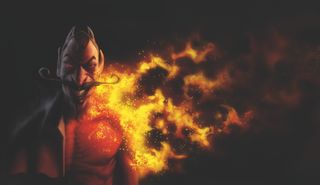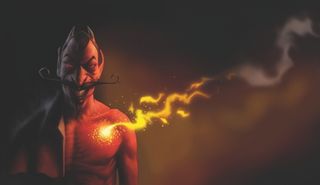Top tips for painting a flaming devil character
Artits Don Seegmiller reveals some simple techniques to successfully paint flames and burning material.
With Halloween fast approaching, what could be more appropriate than a devil with burning flesh? There's no one correct way to paint burning flesh – there are as many ways to accomplish the task as there are artists.
However, all successful paintings of burning materials have one thing in common; the effective use of value. Burning materials and flames are light sources and, as such, must be the lightest elements of any painted image.
The software I used for this image is Painter X3 with default brushes, but the method is easily adapted to earlier versions of Painter or the software of your choice. This particular painting is a stylised version of burning flesh and is an easy technique to follow. The basic method could be used for more realistic or imaginative approaches.

Your starting image must be darker overall than normal. Try to imagine the lightest value in the painting (aside from the fire) as having a mid-value grey. From there, I paint a crackle texture onto the skin surface in a light flame colour, getting gradually darker toward the edges of the burn area. This is the smouldering material at the edges of the flames.
On a new layer I paint the actual flame. This is painted lighter at the point it originates and gradually gets darker further away. On another layer I paint small embers of burning flesh in the air. I finish the image by painting some smoke on an additional layer; once finished, the smoke layer is moved below all the flame layers. As you can see, value is paramount!

Artist's secret
One of the most important things you can do when painting flames is to simplify the process. Use simple shapes and don't try and copy photographs of real flames. Because fire is so abstract, almost anything you paint will look like flames.
Words: Don Seegmiller
Artist, author and instructor, Don Seegmiller teaches in the Art and Visual Communication Department at Utah Valley University. This article originally appeared in ImagineFX magazine issue 102.

Thank you for reading 5 articles this month* Join now for unlimited access
Enjoy your first month for just £1 / $1 / €1
*Read 5 free articles per month without a subscription

Join now for unlimited access
Try first month for just £1 / $1 / €1
Get the Creative Bloq Newsletter
Daily design news, reviews, how-tos and more, as picked by the editors.
The Creative Bloq team is made up of a group of design fans, and has changed and evolved since Creative Bloq began back in 2012. The current website team consists of eight full-time members of staff: Editor Georgia Coggan, Deputy Editor Rosie Hilder, Ecommerce Editor Beren Neale, Senior News Editor Daniel Piper, Editor, Digital Art and 3D Ian Dean, Tech Reviews Editor Erlingur Einarsson, Ecommerce Writer Beth Nicholls and Staff Writer Natalie Fear, as well as a roster of freelancers from around the world. The ImagineFX magazine team also pitch in, ensuring that content from leading digital art publication ImagineFX is represented on Creative Bloq.
